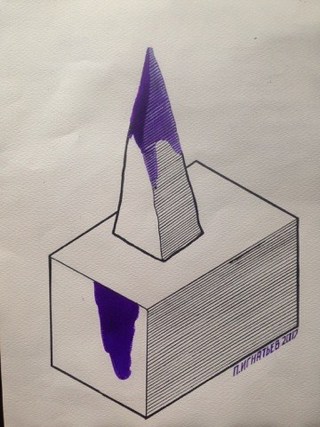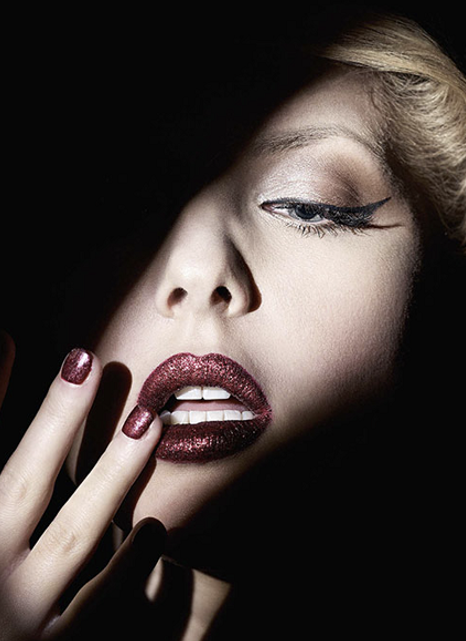Exhibition by Pavel Ignatiev at the Erarta Museum of Contemporary Art offers a look at the world in poisonous purple color
-
Why did the politicians of the 2000s prefer purple ties
-
Modernist selfie, showing us a new man of the 21st century, who we really wouldn’t want to look like
-
The punk brutal objects
The creative genius of Pavel Ignatiev originated and matured in the unique atmosphere of an artists’ house on Pesochnaya Embankment, where his everyday life went side-by-side with the professional practice of his parents-painters and grandfather-graphic artist who created, as they would say in the newspeak of the 00's, the "identity of the festive Leningrad": posters, greetings cards and wine labels. In the cradle of all Leningrad art — the middle art school named after Johanson, Pavel Ignatiev practiced 8-millimeter cinema, experimental mixing on tape recorders and publication of a trash-magazine by “do-it-yourself” technology.
By the time of this one of the rare few solo exhibitions Pavel Ignatiev has long established himself as a sculptor-restorer. This art is extremely necessary for the dank city, generously decorated with marble and concrete gods. Apart from the lost sculptural two-headed eagles and traces of poor management after 1917, the city continues to suffer losses. Ignatiev is a restorer, plunged into the history of old cement and tirelessly progressing in his professionalism. But first of all, he is an outrageously thinking artist with the qualities that are usually attributed to people who are extremely talented or geniuses.
Careful, at times routine and highly responsible work, gives place to staggeringly paradoxical creative expressions! It was Pavel Ignatiev who dressed Trezini in a luxurious bronze fur coat that merged with the curls of the wig and created a waterfall of heavy wool, — the illustration of the Baroque’s adventures in harsh Russian climate.
The naughty genius of the author, for a while shut up in the studio and guided apparently by some irrational impulses began to experiment with office ink, which our grandfathers and grandmothers used to sign postcards.
The purple project by Ignatiev carries the aggressive name of Intervention. This title is consonant with the word “ink”, since we are talking about the intervention of a poisonous ink cloud. The artist attacks from several directions and invades a sterile exhibition space, where the punk brutal objects are rather rare guests.
Ignatiev's “Intervention” is a series of plastic variations illustrating images-insights and personal reflections. It is an excellent example of incomprehensible contemporary art, which becomes even more mysterious when referring to the artist's commentary.
Ageless Ignatiev is interested in contemporary trends, fashion, and places of melancholic reflection of city dwellers, who perceive their “life style” not as a glossy stamp, but as a synonym for “existence”. This series of works tears the muttering and rustling images, generated by the unclear reality, out of the purple fog. Some of them did exist, and something probably will, but it all seems to happen not with us, but somewhere in a space of numerous hyperlinks, where the circulating information does not inform of anything.
The exhibition is nostalgic in a way. It pretends to be a creation of the scene, a super-underground studio in the heart of a former tenant house in western Berlin, where the roar of a drum machine never stops, and the inhabitants never sleep charging their vitality from art. Here is the work devoted to the friends of youth who fell by the wayside — took Jonathan Livingston Seagull too much to heart and have been looking at the ocean through the endless tropical rainstorm for five years now. And here is the series of works where the author asks the question: where are those vaunted technologies and when did the technical progress manage to finish? Ironically, the image of a burning Zeppelin still worries the contemporaries. Perhaps this is what the ungrateful offsprings of the choking Laocoon are contemplating on the surface of a black mirror. And here is a van that came straight from 1968; it was never seen in Leningrad, since that was the year of something quite the opposite to the mass orgy of youth and mystical enthusiasm.
In Ignatiev’s works the man resembles a soulless model, which is terribly uncomfortable in the world. A woman that does not fit in the ideal circle, the Pi number written with decapitated bodies, an exhausted body of a suicide, buried, by some bizarre tradition, facedown. The people in these series present a passive biomass, which, if desired, can be painted in purple or forced to levitate. The sculptural installation “Intervention” is an amazing modernist selfie, showing us a new man of the 21st century, who we really wouldn’t want to look like.
















